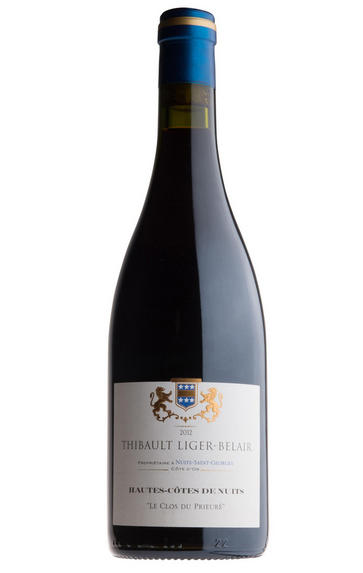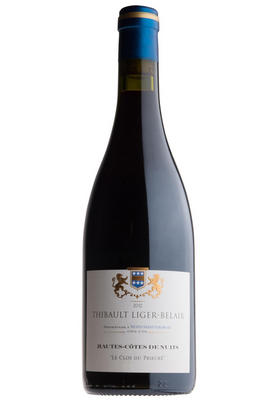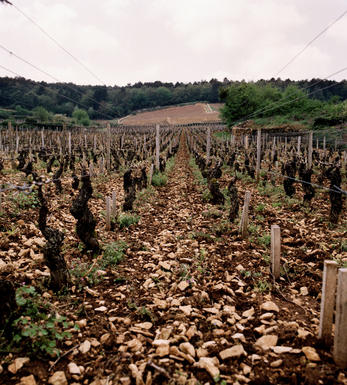
2012 Hautes-Côtes de Nuits, Le Clos du Prieuré, Domaine Thibault Liger-Belair, Burgundy

Critics reviews
Thibault Liger-Belair, who is the cousin of Louis-Michel Liger-Belair (see above), told me that 2012 "was a very challenging vintage from a viticultural perspective. The flowering passed poorly and the growing season itself presented numerous difficulties including notable levels of disease pressure. I began picking on the 24th of September and while the fruit was generally very clean some parcels required more sorting than others. Yields were terrible and depending on the sector we were down from 50 to 70%. By contrast there was good ripeness levels and potential alcohols varied between 12 and 13.5%. I did a bit more punching down than I usually do though it was still a relatively soft vinification. In the same vein I used about 10% more whole clusters in those wines in which I choose to use them. Interestingly the yeasts were lazy in 2012 as it required from 20 to 22 grams of sugar per liter of wine to make one degree of alcohol. [The mandated amount by law is 16.83 grams for reds.] 2012 reminds me of 2008 in this regard as the yeasts were lazy then too. I fermented a bit warmer than usual too but I am happy with the results as the mouth feel of the wines remains quite fine. Because of the small yields I used a bit more new wood though not so much that it marks the wines. The malos took a long time to finish and in some cases they only just finished." My take on the Liger-Belair 2012s is that they are in-line to slightly better than the vintage as a whole.
Allen Meadows - burghound.com - issue 53- Jan 2014
Neal Martin - 30/12/2013
About this WINE

Domaine Thibault Liger-Belair
Domaine Thibault Liger-Belair is part of our Spotlight on sustainability series. You can view the full range here.
Thibault Liger-Belair is cousin to Vicomte Liger Belair of Vosne Romanée. In 2001 he took over an old family property in Nuits St Georges, taking back the vines which had been contracted out to various share croppers, and leased a cuverie just down the road. The family jewels (his branch) consist of Richebourg, Clos de Vougeot and Nuits St Georges Les St Georges, to which he has added further vineyards and a few additional cuvées made from purchased grapes.The vines are now certified organic and farmed biodynamically, with horses used to plough the vineyards where possible. The grapes are rigorously sorted on a table de tri, then destalked and fermented without much punching down or pumping over. They will be racked once during the elevage, but Thibault is not afraid of reductive flavours at this stage which, he feels, adds to the eventual substance and complexity of the wine. The oak regime is not to exceed 50% new barrels but also not to use any barrels more than three years old. The natural style of Thibault’s wines is plump and full-bodied, though the benefits of his farming methods seem to be bringing a more mineral aspect to the fruit as well.
The natural style of Thibault’s wines is plump and full-bodied, though the benefits of his farming methods seem to be bringing a more mineral aspect to the fruit as well.

Hautes-Cotes-de Nuits
Bourgogne Hautes-Côtes de Nuits covers land in 19 communes, stretching from around the hill of Vergy in the north to Magny-lès-Villers, which sits astride the dividing line with the Hautes-Côtes de Beaune.
Arcenant is one of the best wine villages in the Hautes-Côtes de Nuits, and is also noted for the quality of its fruit-based liqueurs such as the Crème de Cassis (as well as Framboise, Pêche de Vigne, Guignolet and more) from Jean-Baptiste Joannet. The leading wine estates are Olivier Jouan and Aurélien Verdet.
Le Clos du Prieuré is located on a south-facing slope above the village, with a white marl and limestone bedrock with affinity to parts of Corton-Charlemagnee, according to Thibault Liger-Belair – whose plot is planted at 10,000 vines per hectare rather than the usual higher training and wider spacing of the Hautes-Côtes. The other main producer is Aurélien Verdet, as before.

Pinot Noir
Pinot Noir is probably the most frustrating, and at times infuriating, wine grape in the world. However when it is successful, it can produce some of the most sublime wines known to man. This thin-skinned grape which grows in small, tight bunches performs well on well-drained, deepish limestone based subsoils as are found on Burgundy's Côte d'Or.
Pinot Noir is more susceptible than other varieties to over cropping - concentration and varietal character disappear rapidly if yields are excessive and yields as little as 25hl/ha are the norm for some climats of the Côte d`Or.
Because of the thinness of the skins, Pinot Noir wines are lighter in colour, body and tannins. However the best wines have grip, complexity and an intensity of fruit seldom found in wine from other grapes. Young Pinot Noir can smell almost sweet, redolent with freshly crushed raspberries, cherries and redcurrants. When mature, the best wines develop a sensuous, silky mouth feel with the fruit flavours deepening and gamey "sous-bois" nuances emerging.
The best examples are still found in Burgundy, although Pinot Noir`s key role in Champagne should not be forgotten. It is grown throughout the world with notable success in the Carneros and Russian River Valley districts of California, and the Martinborough and Central Otago regions of New Zealand.


Buying options
Add to wishlist
Description
A perfumed nose is really quite pretty with its mix of mostly red pinot fruit that is nuanced by hints of underbrush and wet stone. There is a beguiling sense of energy to the supple, round and dusty finish that offers fine persistence if only average depth.
Thibault Liger-Belair, who is the cousin of Louis-Michel Liger-Belair (see above), told me that 2012 "was a very challenging vintage from a viticultural perspective. The flowering passed poorly and the growing season itself presented numerous difficulties including notable levels of disease pressure. I began picking on the 24th of September and while the fruit was generally very clean some parcels required more sorting than others. Yields were terrible and depending on the sector we were down from 50 to 70%. By contrast there was good ripeness levels and potential alcohols varied between 12 and 13.5%. I did a bit more punching down than I usually do though it was still a relatively soft vinification. In the same vein I used about 10% more whole clusters in those wines in which I choose to use them. Interestingly the yeasts were lazy in 2012 as it required from 20 to 22 grams of sugar per liter of wine to make one degree of alcohol. [The mandated amount by law is 16.83 grams for reds.] 2012 reminds me of 2008 in this regard as the yeasts were lazy then too. I fermented a bit warmer than usual too but I am happy with the results as the mouth feel of the wines remains quite fine. Because of the small yields I used a bit more new wood though not so much that it marks the wines. The malos took a long time to finish and in some cases they only just finished." My take on the Liger-Belair 2012s is that they are in-line to slightly better than the vintage as a whole.
Allen Meadows - burghound.com - issue 53- Jan 2014
wine at a glance
Delivery and quality guarantee